Of the many dramatic 3,000m-plus mountains in Taiwan's central mountain range, the gargantuan Tapachien Mountain (
Tapachien Mountain is located in the traditional territory of the Atayal Aboriginal tribe, whose roots can be traced to the first Aboriginal migration from China to Taiwan about 12,000 years ago.
Atayal culture and civilizaton have been severely affected by encroaching modernization, but the tribe of proud, clan-based hunter-gatherers have, nonetheless, continued to inhabit a large area of mountainous central and northern Taiwan and maintained an identity distinct from the far more numerous plains-dwelling Han and Hakka people. In the mountains, those calling themselves Atayal number about 90,000.
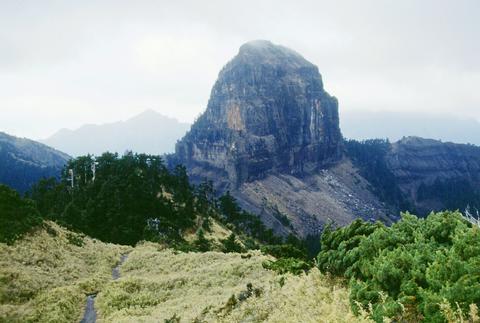
PHOTO: GARY HEATH
Historians are unanimous in tracing the Atayal to southern China, and possibly the Malayan peninsula before that, though no trace of this journey remains in Atayal oral history. However, Atayal oral history and mythology are closely tied to the tribe's land of settlement, and attach particular symbolic significance to several high peaks of the central mountain range, one of the most important of those being Tapachien Mountain.
According to Atayal legend, the place of origin of the tribe is a spot known as Pinsbkan in Nantou County (the word Pinsbkan refers both to the place of creation, and creation itself). Various versions of the cosmogonic myth surrounding Pinsbkan can be found in books and among the Atayal -- not all of whom subscribe to the same set of myths -- but the basic story is that one day a thrush and crow, birds that commonly act as assistants or enablers in ancient mythology, competed to lift a stone to see which of the two was stronger. The thrush lifted the stone highest, then dropped the stone from which the first human couple appeared. There are different versions as to what happened next, but essentially these first male and female humans come together and procreate, forming the Atayal nation.
Tapachien Mountain, known as Papak-Wagu to the Atayal, is an alternative, or additional, site for the above myth. The shape and appearance of the mountain give the impression of being a rock split in two and it is widely believed among the Atayal that the first people originated from such a rock.
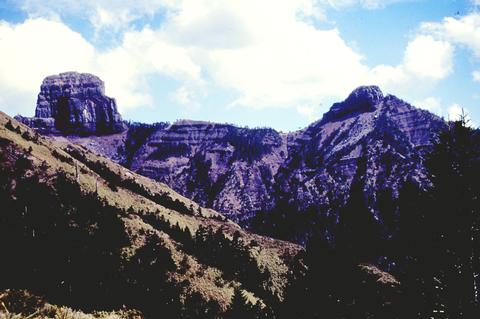
PHOTO COURTESY OF TAIWAN TOURIST BUREAU
The other site connected with the Atayal creation myth is a place known as Bunobon in Taichung County. Pinsbkan, Papak-Wagu and Bunobon are all tall mountains loosely grouped together in a small area and are all connected by ridges, forming a kind of mountain holy trinity in Atayal mythology.
High mountains being a place of creation does have a rationale, as mountains have long been considered to be special places close to heaven where gods reside and dead spirits travel -- Mount Olympus in Greek mythology is an obvious example. For people to have originated from the high mountains may fly in the face of scientific facts as currently known, but must have seemed logical to people who live off the mountains, and used them as a means of communication; they obviously understand them as "good" places.
Tapachien Mountain also plays an important role in Atayal oral history, in which the mountain is featured as a kind of strategic high point from which the tribe spread across the seven counties of northern Taiwan. This part of Atayal history is told in the tale of chief Ikmbuta, a wise and strong leader who one day realized that his people were too numerous and that the tribal lands no longer could support the growing Atayal population. Together with two brave men -- Ikmayan and Ikmyabox -- Ikmbuta left Pinsbkan and headed to Papak-Wagu, or Tapachien Mountain, and from this high point surveyed the world before him. Looking down at the big and little rivers, Ikmbuta was able to chart a mental map of the world he saw and promptly set off with his two companions to find new land to populate, and to mark the expanded Atayal territorial boundary.
Over the years, the Atayal people came to revere Tapachien Mountain in line with its important role in the tribe's cosmogonic myth. The mountain is further considered sacred, being a place where dead souls travel to paradise. If a man had been a brave and successful headhunter, or a woman had been a skilled weaver, for example, then they could complete the journey to paradise via Tapachien Mountain. Finally, Tapachien Mountain is generally respected by the Atayal as the origin of water, and therefore of all nature and life.
A team of Japanese climbers in 1927 were the first to scale the highest peak of Tapachien Mountain. The team reached the top only by temporarily evading their Atayal guides, for whom climbing to the peak was a strict taboo, and making a dash for the summit.
In 1969, metal railings were added to Tapachien's limestone summit, making the climb to the top a popular tourist activity. The railing was taken down, however, after several people died scaling the steep rock face. Today, it is possible to approach the base of Tapachien Mountain, and walk across to Hsiaopachien, the mountain's satellite peak, but making it to the top of the big rock is not a practical proposition -- a case of nature reclaiming a sacred site for an ethnic minority.
And what a rock Tapachien Mountain is. It is a truly majestic jewel of stone in the middle of steep valleys and forested mountains. Although the mountain is the subject of many pictures and postcards, nothing quite prepares you for its arresting and magnetic presence. Reaching the mountain takes a couple of days and includes a grueling hike, but the amazing scenery makes this trek, or pilgrimage, more than worthwhile.
Seen in the early morning, the angular, terraced summit of the 3,492m-tall Tapachien Mountain in black silhouette is a mysterious sight. The more regularly eroded Hsiaopachien Mountain (
It is perhaps not surprising that in the process of constructing myths about their origins and after life, the Atayal turned to the mountains that stand at the center of their world and dominate the topography all around. Even today, it is impossible to go to Tapachien Mountain and be left unaffected by the mystery and grandeur of this majestic peak.
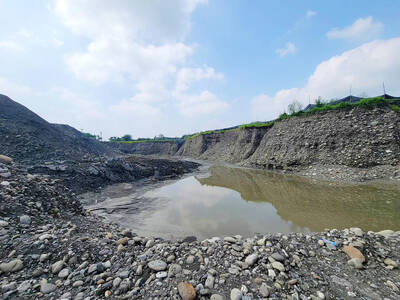
Last week the story of the giant illegal crater dug in Kaohsiung’s Meinong District (美濃) emerged into the public consciousness. The site was used for sand and gravel extraction, and then filled with construction waste. Locals referred to it sardonically as the “Meinong Grand Canyon,” according to media reports, because it was 2 hectares in length and 10 meters deep. The land involved included both state-owned and local farm land. Local media said that the site had generated NT$300 million in profits, against fines of a few million and the loss of some excavators. OFFICIAL CORRUPTION? The site had been seized
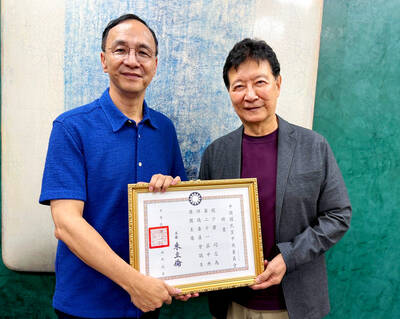
Next week, candidates will officially register to run for chair of the Chinese Nationalist Party (KMT). By the end of Friday, we will know who has registered for the Oct. 18 election. The number of declared candidates has been fluctuating daily. Some candidates registering may be disqualified, so the final list may be in flux for weeks. The list of likely candidates ranges from deep blue to deeper blue to deepest blue, bordering on red (pro-Chinese Communist Party, CCP). Unless current Chairman Eric Chu (朱立倫) can be convinced to run for re-election, the party looks likely to shift towards more hardline
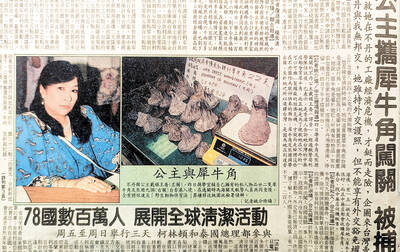
Sept. 15 to Sept. 21 A Bhutanese princess caught at Taoyuan Airport with 22 rhino horns — worth about NT$31 million today — might have been just another curious front-page story. But the Sept. 17, 1993 incident came at a sensitive moment. Taiwan, dubbed “Die-wan” by the British conservationist group Environmental Investigation Agency (EIA), was under international fire for being a major hub for rhino horn. Just 10 days earlier, US secretary of the interior Bruce Babbitt had recommended sanctions against Taiwan for its “failure to end its participation in rhinoceros horn trade.” Even though Taiwan had restricted imports since 1985 and enacted

Enter the Dragon 13 will bring Taiwan’s first taste of Dirty Boxing Sunday at Taipei Gymnasium, one highlight of a mixed-rules card blending new formats with traditional MMA. The undercard starts at 10:30am, with the main card beginning at 4pm. Tickets are NT$1,200. Dirty Boxing is a US-born ruleset popularized by fighters Mike Perry and Jon Jones as an alternative to boxing. The format has gained traction overseas, with its inaugural championship streamed free to millions on YouTube, Facebook and Instagram. Taiwan’s version allows punches and elbows with clinch striking, but bans kicks, knees and takedowns. The rules are stricter than the